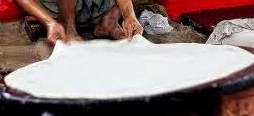K for Kafuli from Garhwal region of Uttarakhand

Coming to K, let me tell you about some dishes in short before turning to Kafuli from Garhal.
First in the list is Kosha Mangsho from West Bengal. "kosha" in Bengali means "bhuna" or deeply sauted, and "Mangsho" is Mutton. So this dish involves slowly cooking a gravy over low flame for a very long time in an iron pan so as to get a rich, dark-brown gravy and tender mutton pieces with special spices of Bengal. It is served with Rice / Polao or Luchi.(Bread).
Another Famous dish is the snacks from Gujarat - "Khandvi" made as rolls from Gram Floor.
Kangsoi from Manipur - is vegetable soup from the east with its unique taste. Another common recipe across India is Korma. It is again a non veg dish, where in meat (or vegetables for veg korma) is braised with yogurt or cream and slowly cooked with water and spices to produce a thick sauce or glaze in the curry.
Now Kafuli. Kafuli is primarily prepared of Spinach and fenugreek leaves. It is an exotic dish, prepared again in an iron kadhai, and served with hot steaming rice. It is the most nourishing and health-conscious dish you will come across the hill state.
Ingredients
Preparation
Aditya Sinha
13.04.2020

Coming to K, let me tell you about some dishes in short before turning to Kafuli from Garhal.
First in the list is Kosha Mangsho from West Bengal. "kosha" in Bengali means "bhuna" or deeply sauted, and "Mangsho" is Mutton. So this dish involves slowly cooking a gravy over low flame for a very long time in an iron pan so as to get a rich, dark-brown gravy and tender mutton pieces with special spices of Bengal. It is served with Rice / Polao or Luchi.(Bread).
Another Famous dish is the snacks from Gujarat - "Khandvi" made as rolls from Gram Floor.
Kangsoi from Manipur - is vegetable soup from the east with its unique taste. Another common recipe across India is Korma. It is again a non veg dish, where in meat (or vegetables for veg korma) is braised with yogurt or cream and slowly cooked with water and spices to produce a thick sauce or glaze in the curry.
Now Kafuli. Kafuli is primarily prepared of Spinach and fenugreek leaves. It is an exotic dish, prepared again in an iron kadhai, and served with hot steaming rice. It is the most nourishing and health-conscious dish you will come across the hill state.
Ingredients
·
Spinach Leaves (Palak)
-2 Cups
·
Methi Leaves
(Fenugreek Leaves) – 1 cup
·
Green Chilli ,
chopped - 2
·
Ginger , chopped –
1 inch
·
Cumin powder (Jeera) –
1tsp
·
Turmeric powder
(Haldi) - 1/2 tsp
·
Coriander Powder
(Dhania) – 1tsp
·
Asafoetida (hing) – a pinch
·
Rice flour 1 tbsp
·
Curd (Dahi / Yogurt) – ½ cup
·
Salt as per taste,
Oil for frying
Preparation
Clean & wash the
spinach leaves and fenugreek leaves and chop them. Add the leaves along with
green chilli, salt and little bit of water in a pressure cooker and cook for 2 to 3 whistle.
Let the cooker open. Scoop the cooked leaves and grind it in the grinder to form a smooth paste.
Heat an iron pan with
oil, add hing and let it crackle. Add ginger, allow it soften. Add spinach paste & keep stirring. Add spices powder and salt and keep stirring.
In a separate bowl mix rice flour with 1/2 cup of water and pour in the gravy mixture.Add the beaten curd
to the mixture and keep stirring until the gravy thickens. Check for salt and
garnish it with ginger.
Serve the Garwhali Kafuli with steamed Rice or Missi Roti.
Aditya Sinha
13.04.2020
Other Recipe as part of A to Z challenge
A - Appam, B- Bhutte Ka Kees, C - Chhena Poda , D - Dhuska, E - Eromba F- Fish Curry (Goan) , G - Gulaoti Kebab, H - Halwa Paratha, I- Idiyappam, J - Jadoh
Other Genres in the Challenge :






















